Page contents
Standard parking bay
What this garden shows
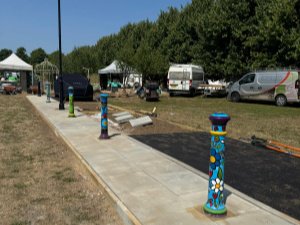
This garden includes a standard parking bay, like the thousands you see across Surrey. A key feature of the garden is the visual contrast it presents. A key feature of the garden is its striking visual contrast.
We acknowledge the necessity of car parking spaces on our streets, therefore these parklets are also to brighten up overlooked areas lacking greenery.
It's essential to strike the right balance between accommodating parking needs and creating spaces for wildlife, greenery, and people. Side by side, visitors will see an ordinary car parking space with a vehicle next to transformed parking spaces with planting and seating.
The side-by-side view will highlight how such transformations can uplift and enhance urban areas and how much more we can get out of our streets.
Who helped with this garden
Local business Walton Audi lent us a brand-new, electric Audi Q4 to represent a typical car parked on a Surrey street. By using an all-electric model, we are recognising that cars will always be part of our lives while promoting a more sustainable alternative option to petrol and diesel vehicles.
Ringway provided materials including bollards, tarmac and the parking sign, and helped build the garden, including laying the tarmac. Students from North East Surrey College of Technology (NESCOT) also worked alongside Ringway to help construct parts of this garden.
M Group Highways donated the streetlight on display, helping visitors imagine what a real streetscape could look like.
Where this garden will go after the show
The vehicle will be returned to Walton Audi for resale. The black bollards, kerbs, and parking sign will go back to Ringway to be used on real streets across Surrey.
The streetlight will be reused by M Group Highways in another Surrey location and the tarmac for the surface will be broken down and recycled into a base material for future projects.
Walton parklet
What this garden shows
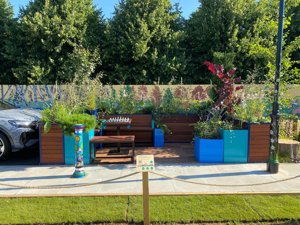
The Walton parklet transforms a parking space into a vibrant, people-centric area with places to sit, relax, and connect with others. It includes 12 planters with built-in seating made from polyester powder coated steel and timber, so people are surrounded by greenery while sitting near the road.
There is also a table with a chess board to encourage people of all ages to come together and play or simply enjoy lunch. The seating area is wheelchair accessible, so anyone can sit around the table comfortably.
What plants we've used
The plants in this garden includes species that help clean the air by absorbing vehicle pollution. Hardy plants like cotoneaster, known for capturing carbon, are mixed with pollinator-friendly plants like ivy.
Two feature trees, forest pansy and field maple provide shade, and offer a cool, relaxing spot for people to rest and improve wellbeing.
The Walton garden is filled with purple flowers, reflecting the colours of Walton Business Improvement District (BID), who work to make the town more welcoming and vibrant.
Who helped with this garden
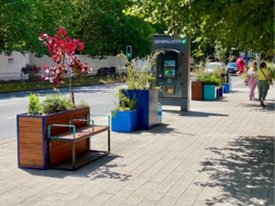
This parklet was designed by the council and we put the planting list together, working with Meristem Design and Love Walton Business Improvement District (BID). Meristem Design constructed the planters and seating, including sourcing and planting the plants, and will also take down and relocate the garden after the show.
Where this garden will go after the show
This parklet will be moved to New Zealand Avenue in Walton, where it will be set up in a straight line to fit the space on the pavement. Love Walton BID has created a not-for-profit company to manage and maintain the garden.
They’ll handle the day-to-day care of the plants and planters so the public can continue to enjoy the space. This project leaves a lasting legacy by bringing the community together, helping people make new friends and giving volunteers a chance to learn new skills and practise gardening.
Cranleigh Garden
What this garden shows
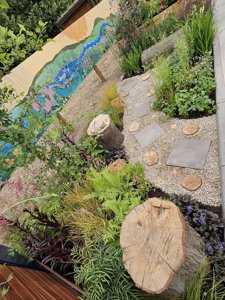
This rain garden transforms a regular parking space into a sustainable green area that helps manage rainwater and reduce flooding. In cities, rainwater often has nowhere to go because of all the concrete and tarmac, which can lead to flooding and pollution. Rain gardens are a simple solution that mimic natural drainage by soaking up rainwater, filtering out pollutants, and helping it slowly return to the ground.
The garden includes special kerbs with gaps that let water run off the road and into the planted area. It’s filled with plant species that thrive in both dry and wet conditions, showing how urban spaces can be more resilient to climate change while supporting wildlife and improving water quality.
A path made of slabs and stepping stones lets people walk through the garden and encourages “play on the way”, a fun way to make walking more enjoyable. Rustic log benches made from a fallen tree, provide natural spots to rest and bug hotels made from bamboo help attract bees, butterflies, and ladybirds, showing how small changes can support biodiversity.
By combining greenery, smart water management, and space for people and wildlife, this garden shows how we can rethink our streets to be healthier, more sustainable, and more enjoyable for everyone.
What plants we've used
The plants in this rain garden were carefully chosen to thrive in both wet and dry conditions. It includes moisture-loving plants like sage and masterwort that help soak up rainwater from the road.
Other plants, such as willow-leaved loosestrife and knotweed, can handle drier conditions once they’re established. There’s also a birch tree that thrives in wet soil but can also cope with dry spells, adding height and shade to the garden.
Who helped with this garden
This garden and the planting selection was designed by AtkinsRealis, who worked alongside the council. Ringway and students from NESCOT helped build and will later take down the garden for the RHS Hampton Court Flower Show 2025.
The bug hotels have been created from leftover bamboo and wood from the Saw Mill. Built by three generations of a family in Surrey with the oldest being 80 years old and the youngest being 11 years old.
Where this garden will go after the show
The plants will be relocated in rain gardens being built in Fountain Square, Cranleigh. The wooden stepping stones will go back to the council to be used in ‘play on the way’ schemes. The wooden log seating will be recycled, and the kerbs will be returned to Ringway to use in other schemes.
Information about rain gardens
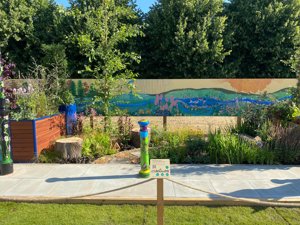
In urban areas dominated by concrete and tarmac, rainwater often has nowhere to go, leading to flooding and pollution of waterways. Sustainable Drainage Systems (SuDS) help tackle this by mimicking natural processes to manage rainwater more effectively.
They focus on four key principles: water quantity (reducing flood risk), water quality (filtering out pollutants), amenity (creating attractive, usable spaces), and biodiversity (supporting plants and wildlife).
Rain gardens are a great example of SuDS in urban environments. They collect and absorb rainwater, slowing its flow, cleaning it naturally, and providing a beautiful green space for people and pollinators.
A rain garden is a shallow, planted dip in the ground that collects rainwater from hard surfaces like pavements, and roads. Water flows from these surfaces into the rain garden, where it soaks into the ground gradually.
The plants, soil, and layers beneath help filter out pollutants, reduce flooding, and recharge groundwater. The garden also provides a habitat for birds, bees, and butterflies, making it both practical and beautiful, bringing nature back into urban areas. Rain gardens are a simple yet powerful way to make our cities more resilient.
Guildford parklet
What this garden shows
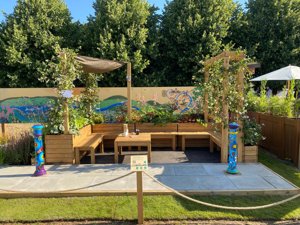
The Guildford parklet transforms a parking space into a vibrant area for birds, wildlife, and people, using reclaimed materials. The parklet includes planters with built-in seating providing a comfortable pleasant space for people to rest, socialise and interact with nature.
A bird bath, made from an old highways sign, collects rainwater through bamboo tubes that also water the plants. This shows how simple ideas can help manage water in a sustainable way.
The garden features two canopies. One has been created from a repurposed parachute to provide shade from the sun and shelter from the rain. The water run-off from this parachute will also fall into the birdbath.
The other canopy has been created by jasmine growing around a timber structure, creating resting spots for birds and wildlife. The garden features pollinator-attracting plants, promoting biodiversity.
What plants we've used
The Guildford garden is full of colour and scent, with plants chosen to brighten the space and support wildlife. Deep red masterwort, sweet-smelling star jasmine, and sky-blue blooms from cranesbill bring variety and vibrancy.
Coral bells adds warm tones with hot pink undersides, while siberian bugloss (jack frost) shows off silver leaves with green veins. These plants not only look beautiful, they’re also low maintenance, help cover the ground and attract bees and other pollinators.
The planting was designed Molly Klemova-White, from Surrey’s Youth Offer team, and colleagues from the council.
Who helped with this garden
The initial design of this garden was created by volunteers from the Rosamund community garden. Designers from Atkins Realis and the council built on this to create the garden on display at RHS Hampton Court Flower Show 2025.
Molly Klemova-White alongside colleagues in the Youth Offer Service helped to grow and advise on the plants used in this parklet.
The repurposed oak wood, used to construct the timber planters and benches were donated by the flood and resilience team, demonstrating sustainability.
This garden is also a great example of teamwork. The Youth Offer Team at Surrey County Council guided young people in building the benches and planters, giving them hands-on experience and the chance to see their work featured at both the flower show and later in Guildford town centre. The team also helped turn an old highways sign into a bird bath.
Where this garden will go after the show
After the show, the garden will be relocated to Phoenix Court in Guildford town centre. This location will provide a perfect setting for the garden, allowing visitors to enjoy its beauty and tranquillity amidst the bustling town and bringing vibrancy into the area. Experience Guildford (BID) will help to organise the maintenance of the plants.
